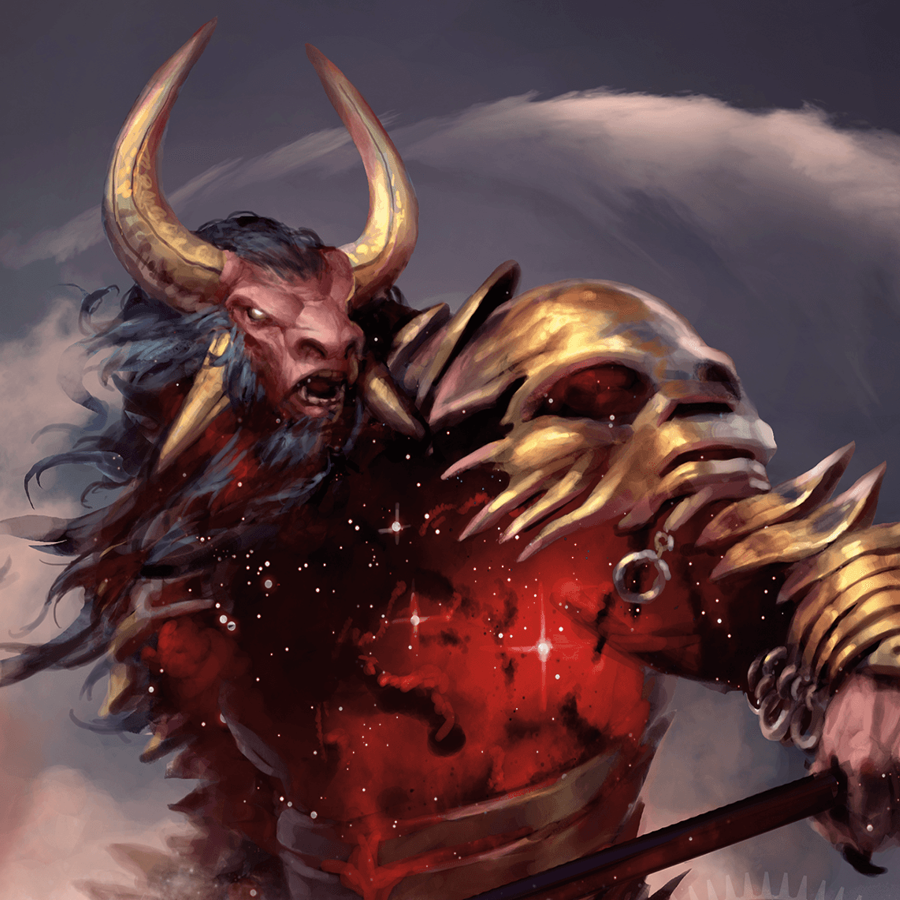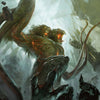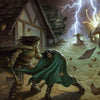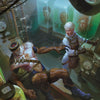How to Create a Sandbox Game in D&D

Written by Luke Hart
Jon was once in a D&D game that the dungeon master, Michael, claimed was a sandbox game. The players were free to explore the world as the group desired, go on the adventures they wanted, and pursue character goals—such as becoming a lich, which Jon’s wizard really wanted to do—well, the works. The campaign was pitched to the players as having the ultimate freedom to do what they wanted. So, yeah, who wouldn’t be on board with that sort of thing? Sounds like tons of fun, right?
The campaign started out OK. They were in a tavern, there was a bar fight, and they spent the night in jail—but they interrogated the crap out of a cellmate and found out about a powerful magic sword guarded by barrow wights. So, once they were released, they set off to slaughter some wights and collect some sweet, sweet loot.
However, as that adventure progressed, and then later the campaign, it became apparent to Jon that the dungeon master was essentially pulling everything out of his butt as the game went along. That is, he wasn’t really planning anything in advance; he was just making everything up on the fly.
Now, Jon’s not dumb. He knows that a good part of being a dungeon master is improvising because players often take left turns at Albuquerque. However, there were so many times that the players made their intentions clear, and Michael could have prepped an adventure if he had wanted to. He just . . . for some reason . . . didn’t.
Here’s the thing. This wasn’t Jon’s first D&D campaign as a player. His previous game was with a different dungeon master, Samantha, who ran an amazing game. Jon knew from talking with Samantha that she was a meticulous planner and took time outside the game to ensure that her adventures were tight.
This isn’t to say that the “sandbox” game Jon was in was bad exactly; there were certainly fun parts to it. However, he couldn’t help but notice the night and day difference between Michael’s game and Samantha’s. The more he thought about it, the more he preferred Samantha’s game style.
Sure, the players didn’t have as much freedom exactly, but the game was a heck of a lot more fun. It was also more action-packed because the group didn’t have to wait around for the DM to look things up or quickly plan an encounter on the fly. They spent more time actually playing the game, and that was huge.
Of course, this got Jon thinking: Why couldn’t his current dungeon master stick with running a sandbox game style but also take the time to prep the adventures more instead of just making everything up on the fly? Wouldn’t that capitalize on the best of both worlds? I mean, would that be too much to ask?
Now, Jon’s observations are completely on the mark; in fact, they underscore a common misconception out there: that running a sandbox game means planning nothing and making everything up on the fly in response to character actions. Nothing could be farther from the truth.
So, today we’re discussing how to run a sandbox game in a way that gives your players the freedom to pursue what interests them but also take advantage of the power of preparing content in advance.
Before we jump in, if you run 5th edition games and are looking for professionally developed DM resources you can use in your games, your search stops with Lairs & Legends 2 and Loot & Lore 2! Get an anthology of everything you need to run amazing games for years to come at your fingertips.
- Over 30 Adventures
- 30 Stand-Alone Encounters
- More than 100 Monsters
- 6 New Rule Sets
- Puzzles, Traps
- And more!
You can watch the video for this article below.
What Does It Take to Run a Sandbox?
Arguably, one can run a sandbox campaign in several ways, but all good sandbox games share some things in common.
Since there isn’t usually a planned story or GM direction to a sandbox—that is, the players’ characters have tons of freedom to do what they want, when they want—a common misconception is that a sandbox game takes less prep than a more linear adventure. However, that couldn’t be farther from the truth.
A good sandbox campaign, properly run, will take at least as much prep as a more linear game, if not more. And why is that, you may ask? There are two reasons:
First, one thing that defines a campaign is its “story through-line.” This is the ongoing, continuous story that makes the players feel like the adventures and scenes in the game are all part of a larger, ongoing narrative. And let me tell you, creating that feeling in a sandbox campaign can be incredibly difficult and take quite a bit of effort.
The second reason is that in a good sandbox campaign, the dungeon master isn’t just making everything up on the fly. They are still preparing adventures, encounters, and the like in advance. There is a special caveat to that which can make it more challenging, but we’ll get into that in just a little while.
Finally, so we can be completely clear on this point, a sandbox game that consists of the dungeon master winging it and making everything up on the fly is almost assuredly going to result in a less engaging game and could also result in a directionless one. This is a game where the players don’t really know what they should do, so they just sort of wander around stirring up trouble where they can find it.
Dungeon masters often complain about murder hobo players, but sometimes it’s our own darn fault!
Step 1: Determine the Campaign Structure
Your first step in designing a sandbox campaign is deciding the structure of your campaign. For instance, will there be clear, obvious plot hooks being delivered to players, and then they’ll need to make choices? Or will you be using more points of interest in your game or straight up running a hex crawl?
Will your campaign be centered on a single home base, or will it involve the characters traveling the breadth of the continent?
What will the tone of the campaign be? Epic adventure? Dark fantasy? Sword and sorcery? Light and comedic? Determining the tone is important to almost all the prep work you’ll be doing.
By the way, I have a couple of videos if you want to learn more about using points of interest or running hex crawls in your game.
The one type of campaign structure you probably do not want to follow, however, is that of plopping the characters down in a location without any hooks or any plans and just expecting them to figure things out. That is going to be a massive flop unless you’ve specifically discussed running a West Marches style of campaign with your players, and they are all on board with that.
Of course, in that case, your campaign structure will look more like this: 1) The players decide what their goals are and what they want to do as a group; 2) The dungeon master prepares the adventure between game sessions; 3) The group convenes to run the adventure that the DM prepared for them based on their goals.
You see, you’re still not just pulling things out of your butt; you’re still preparing stuff for the group to run.
Step 2: Create the Home Base or Originating Location
Your next step is to create the home base—this is the town or city where the characters will start the game and where most of the campaign will take place—the originating location. This is where the PCs begin the game, but where they will only stay for a period of time before moving on to other locales.
To get started, ask yourself: Will the central or originating location be a stronghold, town, city, or something else? Now, most of these locations are static, but the idea of a mobile base like a carnival is completely viable—and could be tons of fun. It gives your players something familiar to return to, but the environment is also constantly changing, which staves off boredom.
Whatever the central location is, you should also develop the key NPCs, usually reoccurring ones, that will provide support to the characters. These are the blacksmiths, jewel buyers, magic shops, and the like. Bear in mind that the NPCs should be engaging; you want them to make the game more fun, not more mundane.
Ideally, you want the players to come to like these NPCs for whatever reason, be it a silly voice, over-the-top expressions, or whatever, and develop an attachment to them. If characters don’t have an attachment to these NPCs or a reason to like and enjoy having them in the game, the NPCs fall flat, don’t contribute meaningfully to the game’s enjoyability, and don’t give the characters a reason to even come home.
Finally, if the players don’t care about the NPCs, you can’t threaten them or kill them in order to motivate the characters. I mean, you could, but the players will just be like, “Whatever; kill the blacksmith. No one cares.” Not that any respectable game master would ever threaten someone a character holds dear to provide drama and excitement in the game.
Whenever possible, in a sandbox, it is always a good idea to have something familiar and interesting for the characters to return to, be it the location or the NPCs inhabiting it.
Step 3: Develop the Surrounding World
First, make or find a map. The map doesn’t have to be an entire world; it just needs to be a couple of days’ journey around the home base or originating location. That is all that’s really necessary at first. Naturally, the players should receive a version of this map—though it shouldn’t include all the private GM markup information that your version is likely to have. Only place information on the map that you think the character would reasonably know; everything else should remain a mystery until they discover it for themselves.
Along that train of thought, sandbox campaigns work best in a world that is not fully explored—or at least one with plenty of locations to explore and adventure in. Part of the excitement of many sandbox games is not just doing the things you want to do; it’s also visiting unique and interesting locales you might want to explore and discover something cool.
As with most things related to GM prep, only create what you need. This saves you tons of time and unnecessary work.
Here are some quick-fire things to consider when fleshing out the surrounding world: factions, politics, the populace’s attitude toward adventurers, the local economy, and places that support adventurers (blacksmiths, weaponsmiths, alchemists, healers, and the like).
If you want to learn more about worldbuilding, I suggest checking out my video on the Supreme Worldbuilding method.
By the way, if you’re not sure what you will need, the best place to look for this information is the characters themselves. A cleric PC needs a god or pantheon and probably some local churches or temples. A wizard may need a library or guild where he can learn new spells. A warrior will need a place to buy weapons and armor and perhaps some trainers.
Once the campaign starts, you can always create more of the surrounding world as you go. Don’t fall into the trap of delaying your campaign from starting for months or years because you need to flesh out everything in the world first. I mean, if you just want to worldbuild, that’s fine. But if you want to run D&D or Pathfinder 2, keep worldbuilding what’s absolutely needed so you can actually play the game.
Step 4: Create Some Plot Hooks
Remember that you’re not just dropping your characters into the world with nothing to do. It is your job as the game master to create interesting problems, conflicts, and situations that will inspire the players’ characters to go off on adventures. To that end, you want to create a handful of plot hooks for the characters to discover as they start playing.
In essence, a plot hook presents the characters with a problem that needs resolving. The duke’s daughter is getting married, but this or that nobleman has been sabotaging the wedding preparations. The duke’s daughter was going to get married, but assassins killed the groom. The duke is dead, his daughter is dead, and now the region is in complete turmoil.
Whatever. Pick your poison, and pick several of them. You then take these three or four plot hooks that you created and present them to your players’ characters. These could be rumors they hear at an inn, wanted posters in the town square, or literal NPC quest-givers that approach and ask them for help. One way or another, make sure they get the plot hooks.
Remember, a good plot hook does three things: It clearly explains the problem; has something that will motivate the players and/or characters to do the thing—that is, a reward of some sort, be it gold pieces, a magic item, or just the knowledge that they are doing the right thing; and finally, it should tell them where or how to get started. You know, so they aren’t just wandering around randomly. “Gee, we know we need to find the groom’s assassins, but where to start? I guess we just start wandering about the city.”
By the way, too many plot hook options can cause analysis paralysis, making deciding what to do next a real pain. Three or four plot hooks or adventuring locations offer plenty of options for players. Two options make it look like there are no options. Five or more, and it starts to drag down the decision-making process.
Furthermore, do not give the players plot hooks for places you don’t want them to go or things you don’t want them to do. This may seem like common sense, but it’s an easy trap to fall into. I was once running a Curse of Strahd campaign, and I was tossing out plot hooks like they were candy. Many of them were for places designed for much higher levels than my players were. Now, my players were veterans and knew better than to go to Castle Ravenloft at level 2, but not all groups will benefit from this knowledge. For a homebrew sandbox campaign, they could have no clue that the Swamp of Eternal Dread that you mentioned is way too dangerous for them quite yet. So, you know, don’t mention the swamp until you’re ready for them to go there, right?
Once your players have the plot hooks, they simply choose the one that interests them the most, and that’s the thing they’ll go off and do. Ideally, your players will tell you this toward the end of a game session or by email or something so you can create the adventure away from the table—because, well, you’re probably not going to create three or four full-blown adventures upfront before you even know what they’re going to do. I mean, you could, but wow, that would be tons of work, and many of the adventures would never get used.
Step 5: Create Some Adventures
Now that your players have presented the players with the list of plot hooks and they’ve chosen the one they want to do, you simply have to plan and run that adventure.
However, what do you do when the campaign starts? I mean, presenting plot hooks and planning an adventure between sessions works great once the campaign is in full swing, but what do you do at your first game session?
Simple. Since you don’t know what your players will do that first session, it’s a good idea to create plot hooks that represent short, simple adventures. That way, you can have all three or four adventures ready to go, and no matter what the players decide to do, you’re ready.
By the way, the five-room dungeon concept works great for these early sandbox adventures. However, I wouldn’t recommend it for regular adventures that you’ll run throughout the rest of the campaign.
A great strategy for integrating future plot hooks into your campaign is by placing them in the adventures themselves. They might find an evil priest’s journal that mentions a crypt full of treasure, or a letter from one bad guy to another. Having characters discover plot hooks in adventures organically is a great game design approach and avoids having to rely upon the overused NPC quest-giver strategy.
Also, as you’re making future plot hooks, do your best to develop them based on what has already occurred in the campaign. This helps you create that story through-line that will give players the sense of a continuous story or narrative unfolding as they play the game.
Of course, there is nothing to stop you from running the sort of campaign where players’ characters pursue their own goals and interests. As long as they tell you in advance so you can prepare adventures for them, that can work just fine for a sandbox campaign. You could even run a mix where you give them plot hooks to follow sometimes, but they pursue their own goals at others.
Now, part of building adventures is creating villains, and something I want to mention here is that villains should be proactive. Villains need to have ambition and plans that draw the characters in. Villains that just sit in their dungeon and wait for characters to come get them are boring.
No, no, no. Villains should be out in the world doing villainous stuff! They should be committing evil deeds that the characters will hear about in the inn while they’re grabbing a drink. They should be sacking villages and stealing sheep—I don’t know, the stuff bad guys usually do. These activities will then be the hooks that draw characters in and lead them to them.
Finally, in a sandbox campaign, it’s critical that characters’ actions have consequences for good or ill. This helps develop the story of the campaign in your game world. This means that as the characters are doing things, you should be asking yourself: “How would this affect the world around the characters?” And you then use that information to develop your next plot hook or point of interest.
For instance, if the characters manage to rescue the dragon from the evil princess, but all of the dragon’s eggs are broken in the process, what would happen as a result? Will the dragon harbor it against them, possibly striking back at the characters’ own family members? Will the evil princess laud the characters as heroes and offer them a job?
Allowing character actions to cause a ripple effect in your game world is amazingly satisfying for players and can take your game to the next level!
By the way, if you need help creating adventures, I have tons of adventure-creation videos on my channel that can help.
Step 6: Track Time!
Adventures don’t just sit around waiting for the characters. In my Thieves Abound Pathfinder 2 campaign, there is a job board in Frostmantle where the characters can choose some adventures. However, the same jobs aren’t there forever. If they go off to this or that dungeon and return a month later, the chances are that most of those jobs will be gone. Either other adventurers have taken care of things, or the situation has gotten even worse, and things have evolved.
You see, time is another great generator of consequences that lead to the feeling of a living, breathing world and help the group create a campaign story.
Step 7: Develop a Random Encounter Table or Two
As in any type of D&D game, having random encounters in a sandbox campaign helps flesh out the world and allows fun little surprises to find the characters. Having random encounters handy also helps you fill in gaps in the game session.
Now, I wouldn’t have every encounter on a table be exactly for the characters’ level. Remember, it’s perfectly OK to introduce creatures that the characters should avoid or run from, as well as things they can easily confront and overcome.
The fact of the matter is that no matter how much you prep, you’re going to have to improvise in your sandbox campaign. To learn about the 15 improv mistakes everyone makes and how to become a master improviser, check out this video.
Lairs & Legends 2 - The Definitive 5e Resource Anthology
Running awesome games with in-depth lore, deadly traps, and terrifying monsters doesn’t have to take hours of prep! Lairs & Legends 2 and Loot & Lore 2 have everything you need to cut your prep time in half while preserving your campaign and your story! These two massive tomes are designed to let you plug-and-play encounters, monsters, magic items, brain-burning puzzles, and more easily into your game!
Or you’ve just needed that one really cool thing for your game, but it’s just not coming to you?
Both books contain hundreds of pages of 5e game master resources, carefully crafted by a team of expert game masters to be both exciting to run and easy to use. You don’t need to parse through dense paragraphs trying to find something useful; just take a quick glance through it and you’ll have everything you need at your fingertips.
Never again feel like you’re stuck with the chore of prep so you can finally run your game: pick up Lairs & Legends 2 today.
-
Posted in
Game Master How-To Articles






